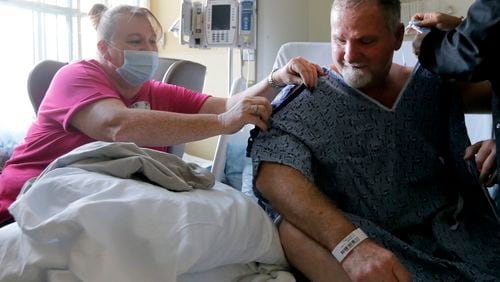Connected to a sea of cables and wires monitoring vital signs, Charles Matheson sits up in a hospital bed, takes a couple sips of coconut water and smiles. For the past four days, his wife, Atlanta Matheson, has barely left his side at Northeast Georgia Medical Center in Gainesville.
She helps her husband, who is 53, talk through a treatment plan with medical staff after he suffered a collapsed lung related to a COVID-19 diagnosis a month earlier. She’s also providing him a steady stream of encouraging words.
“To have her here with me,” said Charles Matheson, on the verge of tears, and holding his wife’s hand, “means everything.”
After more than a year of tight restrictions on hospital visitation — in many cases, banning visitors completely — hospitals throughout Georgia are loosening visitation policies as vaccination rates increase and COVID-19 case counts sharply decline.
At Northeast Georgia Medical Center, a small, trickling number of visitors — all masked — checked in at an information desk on a recent day. Workers kept tallies to make sure arrivals didn’t exceed the limits of visitors for a patient. When it did, the visitors waited for an opening before entering the patient’s room.
With the caps on visits, the hallways were mostly empty.
Across the state, each hospital or hospital system makes its own visitation policies, but they follow guidance from the Georgia Department of Public Health and broad recommendations from the Centers for Disease Control and Prevention. The CDC updated its guidance in April to say hospitals can consider allowing visitors if community COVID-19 levels remain at low to moderate levels.
“We have eased some of our visitor restrictions and begun to allow visitors to our patients on a limited basis at each of our hospitals,” said Northside Hospital spokeswoman Katherine G. Watson in an e-mail. “As always, Northside continues to monitor COVID data and public health guidance to inform our decision making on visitation to our facilities.”
Rules vary from hospital to hospital but the policies apply to all visitors — regardless of vaccination status. In general, hospitals across the state, including Emory, Piedmont and Northside Hospitals, are allowing either one or two visitors throughout their facilities. That includes the emergency room, surgery areas and critical care units.
In labor and delivery units, two visitors are generally allowed, even at hospitals with more restrictive visitation policies in other areas. Some hospitals, including Northeast Georgia Medical Center, allow siblings of newborns to join baby and mom. But children under 16 are still not allowed as visitors in most circumstances.
While hospitals are strictly enforcing the wearing of masks inside public areas of a hospital, some health care workers will allow visitors to take their masks off inside a room with a patient. Public health experts say mask wearing for visitors regardless of vaccination may be here to stay especially as flu season nears.
Coronavirus patients
Only some hospitals, including Northeast Georgia Medical Center and Phoebe Putney Memorial Hospital in Albany, are allowing visitors into the rooms of COVID-19 patients. Those visitors are required to wear PPE including N95 masks, face shields, gloves, and an isolation gown.
Other hospitals, including Emory Healthcare, Piedmont and Northside are not allowing visitors into the rooms of COVID-19 patients at this time, including people who are vaccinated. Some exceptions can be made in special circumstances, such as patients receiving end-of-life care.
Emory Healthcare recently updated visitation policy includes a color-coded, four-tiered graphic for visitation restrictions. These range from a green, “Tier O” low prevalence of COVID-19 when visitor restrictions are lifted, to a red, “Tier 3” high prevalence for COVID-19 with visits only allowed for end-of-life and for patient safety.
Emory, which is only allowing one visitor in most situations, is currently at a “Tier 1” ― which the hospital considers a mild restriction level.
The color-coded policy reflects ever-changing conditions. The number of COVID-19 infections, hospitalizations and deaths in Georgia are at the lowest levels since the earliest days of the pandemic, according to an Atlanta Journal-Constitution analysis of state figures. On Thursday, the seven-day rolling average of confirmed and probable new coronavirus infections in the state was 426, down about 96% since the January peak.
But public health experts warn the pandemic still remains prevalent and they worry that a new strain of the disease, known as the delta variant, could pose new threats. They also worry about the fall and winter months when flu returns.
Visitation lockdowns
Visitation lockdowns were deemed necessary early in the pandemic for health safety and to prevent virus spread. There were also grave shortages of personal protective equipment, or PPE.
But those bans on visits came at an enormous emotional toll. The very sick faced hospital stays without the in-person support of loved ones. Those loved ones often waited anxiously for a call from a nurse or doctor. This was true for all patients, even those who were not battling COVID-19.
Some are questioning whether the restrictions went too far, and say states and hospitals need to set policies that balance safety while recognizing the needs of patients, particularly the needs of patients with serious, life-threatening illnesses and those who are near end-of-life.
“The impact on the patient and the family members, it’s a tragedy,” wrote Dr. Daniel Garros is a co-author of a journal article on the subject published in the July issue of the American Journal of Critical Care.
“Family members of these patients will never forget they were not able to say goodbye to their loves ones, and there’s also the patients dying alone,” he wrote.
Garros, a staff physician at the Stollery Children’s Hospital and clinical professor at the University of Alberta. said the situation also caused deep and lasting psychological scars on health care workers as well.
“This should have never been allowed to happen and we should make sure it never happens again,” he said.
Pam Redman, Piedmont Atlanta’s director of patient experience, said the hospital’s decision to restrict visitors was not an easy one. She and other hospital workers maintained that even when visitors are not allowed, they will consider exceptions, particularly for end-of-life care.
“How do you manage a group of folks when our role is not to keep people away from their loved ones but to keep everyone safe?” Redmon said.
Redman said it’s too early to know what visits will look like during the coming months.
“I don’t think we are over this pandemic to be able to do a comprehensive assessment of what visitation would look like,” she said.
Meanwhile, back at Northeast Georgia Medical Center, James Hardigree of Gainesville sat by the bedside of his mother, Patricia Hardigree, who is 74, and who was undergoing tests to determine the cause of her health’s sudden decline. He was relieved when the ambulance arrived at their house a few days earlier and he learned he would be able to be with his mom at the hospital.
“She’s been in a lot of distress,” said Hardigree about his mother who was resting. “She’s confused. I am here to help keep her calm. It is a hard situation, and it would be so hard if I wasn’t here with her. I can’t even imagine what that would be like.”
VISITATION POLICIES
Each hospital sets its own visitation policy and they can make changes at any time.
In general, hospitals are allowing one or two visitors at a time.
Visitors should be prepared to wear a mask at all times — regardless of vaccination status.
Visitors should check in at an information desk. Workers keep tallies on visitors to make sure arrivals don’t exceed the limits of visitors for patients.







